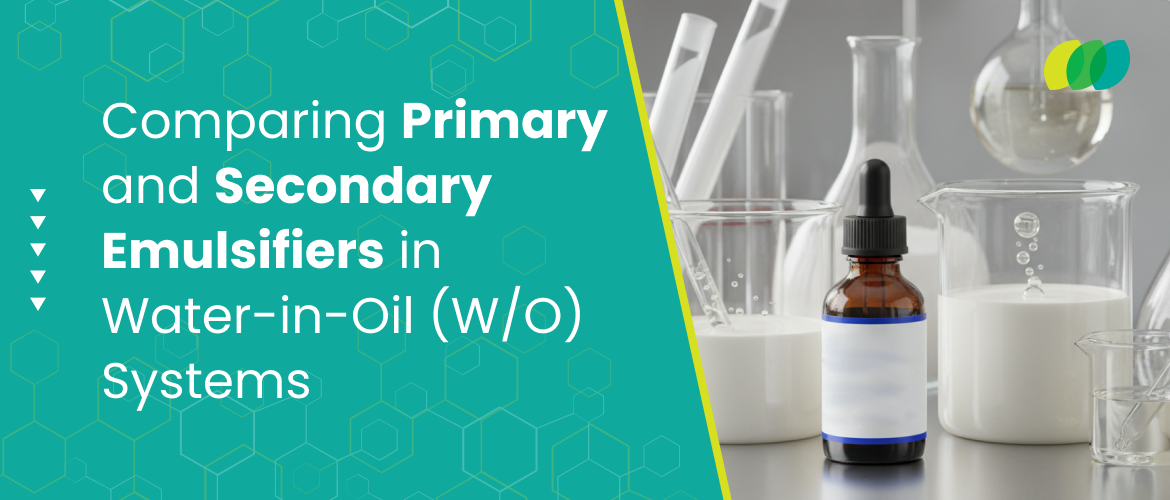Water-in-oil drilling fluids are the backbone of efficient well operations. They provide stability, reduce risks, and ensure projects move forward without costly interruptions. The global drilling fluids market is expected to reach USD 11,274.8 million by 2030 (Grand View Research), and this will lead to an increase in the demand for reliable emulsifiers. Primary emulsifiers and secondary emulsifiers are at the heart of this discussion; these two categories of agents ensure drilling systems remain stable under unpredictable conditions.
What is Primary Emulsifier?
A primary emulsifier provides the foundation of stability in a water-in-oil system. It surrounds water droplets and locks them into the oil phase, preventing them from coalescing or separating out. The drilling fluid’s primary emulsifier creates the base emulsion that gives drilling mud its stability and consistency. Without it, the fluid would break down quickly under pressure or temperature swings.
Dependable performance depends on sourcing from a trusted primary emulsifier supplier or manufacturer. For operators, the quality of this chemical directly translates into consistent drilling performance.
What is Secondary Emulsifier?
A secondary emulsifier does not replace the primary one but strengthens what has already been built. Its main role is to enhance emulsion stability, minimize the effects of contaminants such as salts and drilled solids, and fine-tune fluid rheology. The drilling fluid secondary emulsifier helps systems perform reliably in high-pressure, high-temperature zones while maintaining stability even when exposed to salt or drilled solids.
For operators, consistency again depends on reliable sourcing. A poor-quality supply from a secondary emulsifier can weaken the entire system, even if the primary emulsifier is strong.
Comparing Primary vs Secondary Emulsifiers: A Closer Look
The distinction between primary and secondary emulsifiers directly affects the sustainability and cost-effectiveness of drilling programs.
Role in the System
- The primary emulsifying agent creates the emulsion, essentially building the framework.
- The secondary emulsifying agent reinforces it, making sure the framework does not collapse when exposed to contaminants or pressure changes.
Strength vs Flexibility
- Primary agents are strength-givers. They coat water droplets and disperse them in oil, preventing separation.
- Secondary agents bring flexibility. They assist in the process of adapting the fluid when other factors, such as calcium contamination or cuttings loading, are likely to interfere with the stability of the mud.
Impact on Drilling Performance
- Without a primary emulsifier, there would be no stable emulsion at all. Drilling operations would face early failure.
- An emulsion may form, but without secondary emulsifiers, it is likely to weaken and break down under harsher conditions.
Practical Differences in Use
- In practice, primary agents are added first to establish the emulsion, while secondary agents are introduced later to tighten and stabilize it.
- Secondary agents are subsequently incorporated to tighten the emulsion and give mud engineers additional control over rheology and electrical stability.
When decision-makers evaluate the differences between primary and secondary emulsifiers, the conclusion is obvious: they are both essential. They may overlap in their roles sometimes, but they are not substitutes. When used together, they create a resilient drilling fluid system that can withstand operational challenges.
Why these Differences Matter for Decision-Makers?
Executives and managers may not require molecular-level details, but understanding the practical differences is essential for strategic decisions. An improper balance between primary and secondary emulsifiers can lead to higher chemical consumption, increased non-productive time, and risks to wellbore integrity.
Asking the right questions is what makes the difference. Is the primary emulsifier supplier providing consistent quality? Is the secondary emulsifier tailored to the conditions of the well? Are both chemicals compatible with the overall mud design? These questions guide decisions that impact efficiency and safety.
Final Thoughts
The debate over what is the primary emulsifier and what is the secondary emulsifier is not just technical. It is strategic. The primary emulsifier builds the system. The secondary emulsifier protects it when conditions become unpredictable. For drilling programs, it is not about choosing one over the other – it is about ensuring both are sourced from reliable primary emulsifier manufacturers and secondary emulsifier suppliers.
The reality of drilling is simple: surprises will come. The strength of the emulsion system determines how well those surprises are managed. And the strength depends on the careful balance of primary and secondary emulsifiers.

